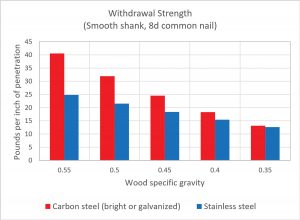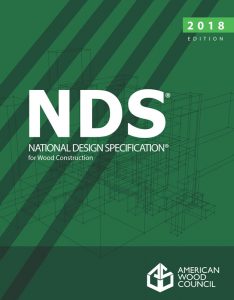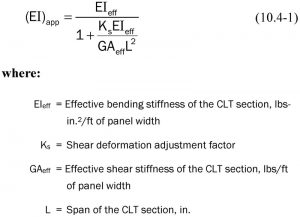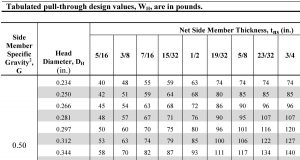The 2018 Edition of the National Design Specification® (NDS®) for Wood Construction was recently published. The updated standard, designated ANSI/AWC NDS-2018, was approved as an ANSI American National Standard on November 30, 2017 (Figure 1). The 2018 NDS was developed by the American Wood Council’s (AWC) Wood Design Standards Committee and is referenced in the 2018 International Building Code (IBC).
Primary changes to the 2018 NDS and the 2018 NDS Supplement: Design Values for Wood Construction include:
- Allowance for incising factors for specific incising patterns and lumber sizes when obtained from the company providing the incising.
- Inclusion of a volume factor for structural composite lumber tension parallel-to-grain values
- Inclusion of effective shear stiffness for cross-laminated timber.
- Added equation for withdrawal design values for smooth shank stainless steel nails.
- New withdrawal design provisions for Roof Sheathing Ring Shank nails in accordance with ASTM F 1667, Standard Specification for Driven Fasteners: Nails, Spikes, and Staples.
- New design provisions for fastener head pull-through.
- Revised provisions for calculation of lateral design values for deformed-shank nails such as Post Frame Ring Shank and Roof Sheathing Ring Shank nails.
- Revised timber rivet design-value tables to limit maximum distance perpendicular to grain between outermost rows of fasteners.
- Revised terminology for Fire Design of Wood Members to clarify the difference between “char depth” and “effective char depth” used in structural calculations. Provisions for connections are also revised to more precisely describe the requirements for protection of the connection from fire exposure.
- Changes to the NDS Supplement include removal of Redwood grades requiring “close grain,” addition of Norway Spruce from Norway to foreign species dimension lumber, and addition of shear-free moduli of elasticity for structural glued laminated softwood timber (glulam).
Structural Composite Lumber
NDS Chapter 8 on Structural Composite Lumber (SCL) was revised to include a volume factor, CV, for tension parallel-to-grain design values, Ft. The change occurs in NDS Table 8.3.1, Applicability of Adjustment Factors for Structural Composite Lumber, and Section 8.3.6 Volume Factor. A change was also made to clarify that dry service conditions are associated with conditions in which the moisture content of sawn lumber is less than 16%, as in most covered structures. These changes correlate with ASTM D 5456, Standard Specification for Evaluation of Structural Composite Lumber Products.
Cross-Laminated Timber (CLT)
Revisions were made to CLT deflection provisions to include the term GAeff (effective shear stiffness of the CLT section). This is a correlating change with ANSI/APA PRG 320-2017, Standard for Performance-Rated Cross-Laminated Timber, to facilitate the calculation of apparent bending stiffness (EI)app consistent with properties as provided in PRG 320. The revised equation, excerpted from the 2018 NDS, is shown in Figure 2.
Changes to Fastener Design
Revision of NDS connection design provisions was primarily in response to significant increases in Components and Cladding (C&C) roof wind pressures in ASCE 7-16, Minimum Design Loads and Associated Criteria for Buildings and Other Structures. Wind uplift related changes include new fastener withdrawal and new fastener head pull-through design provisions.
Added Equation for Stainless Steel Nail Withdrawal Strength

Figure 3. Smooth shank nail withdrawal strength (allowable stress design) from wood in accordance with 2018 NDS.
An equation for the withdrawal strength of smooth shank stainless steel nails was added. Stainless steel nails have lower withdrawal strength when compared to carbon steel wire nails of the same diameter, due to the reduced surface friction of stainless steel. The differences in withdrawal strength vary with the specific gravity of wood (Figure 3). When stainless steel nails are specified as an alternative to reference smooth shank carbon steel wire (bright or galvanized) nails in wood construction including shear walls and diaphragms, these differences in nail withdrawal strengths must be considered. For example, where smooth shank stainless steel nails are used for roof sheathing attachment, more nails, or nails of greater length or diameter, may be required to provide equivalent withdrawal strength performance for wind uplift.
Roof Sheathing Ring Shank Nails
Roof Sheathing Ring Shank (RSRS) nails were recently added to ASTM F 1667, Standard Specification for Driven Fasteners: Nails, Spikes, and Staples. Design provisions for RSRS nails have been added to the 2018 NDS. RSRS nails, which have higher withdrawal design values than smooth shank nails, provide additional options for efficient attachment of wood structural panel roof sheathing. In many cases, the specification of RSRS nails produces a more reduced roof sheathing attachment schedule than permissible by use of smooth shank nails and enables the use of a single minimum fastener schedule for roof perimeter edge zones and interior zones. Recognition of higher withdrawal strength in the NDS is based on the presence of standardized ring deformations including minimum 1½-inch length of deformations on the nail. In a related change, tabular values for generic threaded-hardened nails, which had no standardized deformation pattern, were deleted to remove an approximate 10% increase in withdrawal values for such nails relative to smooth shank nails of equivalent diameter. The revised NDS provisions allow these generic deformed shank nails, in accordance with ASTM F 1667, to use withdrawal design value equations for smooth shank nails.
Fastener Head Pull-through Provisions
Combined with historical data from tests of lumber and plywood, fastener head pull-through data used to set industry recommendations for wood structural panels was analyzed to develop new fastener head pull-through provisions. Within the range of head diameters, thicknesses, and specific gravities in the NDS, the analysis found that head pull-through is related to the perimeter of the fastener head. New equations based on fastener head diameter, specific gravity, and net side member thickness are as follows:
WH = 690 π DH G2 tns for tns ≤ 2.5 DH
WH = 1725 π DH2 G2 for tns > 2.5 DH
where:
π DH = perimeter for fasteners with round heads
DH = fastener head diameter (in.)
G = specific gravity of side member
tns = net side member thickness
An excerpt of tabulated head pull-through values from 2018 NDS Table 12.2F is shown in Figure 4.
For design of roof sheathing fastening to resist wind uplift, the addition of head pull-through allows the controlling roof sheathing fastener spacing to be calculated from the lesser of the head pull-through design value or the fastener withdrawal design value from wood in accordance with the NDS. Previously, such design required the use of a combination of design documents including minimum prescribed spacing criteria for wood panels.
Although not specifically addressed by the added head pull-through equations in the NDS, which assume fasteners with round heads, analysis of underlying data is considered to support the use of the fastener head perimeter model for fasteners with other than round heads such as proprietary nails with clipped or oval heads.
Diameter for Threaded Nails
A change in ASTM F 1575, Standard Test Method for Determining Bending Yield Moment of Nails, clarified that nail bending yield strength, Fyb, is based on the nominal diameter, D, not on the smaller root diameter, Dr, portion which is stressed in bending in the standard test. This change allowed nail moment capacity from testing to be represented by D and Fyb, and simplification of lateral design value calculation because Dr is not always provided for deformed shank nails. NDS provisions are revised to allow the use of D for deformed shank nails per ASTM F 1667 and applicable bending yield strength for calculating lateral design values.
Lateral Design Values for RSRS and Post Frame Ring Shank Nails
Lateral design values for RSRS and Post Frame Ring Shank nails are tabulated in accordance with revised provisions based on the use of diameter, D, and applicable bending yield strength. For purposes of lateral design, a deformed shank RSRS or Post Frame Ring Shank nail has the same lateral design values as a smooth shank nail of the same diameter, bending yield strength, and length. For Post Frame Ring Shank nails, revised tabulated lateral design values are based on the bending yield strength of low to medium carbon steel, as opposed to the higher values associated with hardened steel nails per ASTM F 1667, due to greater use of low to medium carbon steel nails in construction. Relative to former tabulated lateral design values for the Post Frame Ring Shank Nail, the combined effect of the use of diameter D in calculation and lower bending yield strength resulted in new design values ranging from 7% lower to 3% higher than previously tabulated.
Fire Design of Wood Members
NDS Chapter 16 on Fire Design of Wood Members was revised to provide separate calculations of char depth based on nominal char rates for wood, achar, and effective char depth for use in structural calculations, aeff. Increased use of wood as a fire protective covering has made it important to provide provisions for calculation of the expected achar separate from aeff. Previous versions of the NDS have only provided aeff, which is increased 20% over achar to account for loss of strength and stiffness due to elevated temperatures in uncharred wood near the char front.
Design of connections for fire was also clarified as follows:
Wood connections, including connectors, fasteners, and portions of wood members included in the connection design, shall be protected from fire exposure for the required fire resistance time. Protection shall be provided by wood, fire-rated gypsum board, other approved materials, or a combination thereof.
These provisions, while not intended to be technically different from current NDS provisions, clarify that protection of all components of the connection (connectors, fasteners, and wood) must be protected from fire exposure for the required time.
NDS Supplement
NDS Supplement design values are unchanged from prior NDS Supplements with only a few exceptions. New and revised grades of machine stress-rated lumber and machine evaluated lumber are added. Redwood grades requiring “close grain” were removed due to general lack of availability for commercial use. Other revisions include the addition of Norway Spruce from Norway to foreign species dimension lumber and the addition of shear-free moduli of elasticity for structural glued laminated softwood timber (glulam). As a compendium of product types, species, grades, and sizes, a note has been added to the NDS Supplement to alert designers and product specifiers to check for availability of sizes and grades of products before specifying.
Conclusion
A section by section list of changes to the NDS is available in an appendix to this article, free to download from the AWC website.
The 2018 NDS with 2018 NDS Supplement is currently available in electronic format (PDF) only. Once the NDS Commentary and other support documents to be included in the 2018 Wood Design Package (WDP) are updated, printed copies will be available for purchase. Check the AWC website (www.awc.org) for status updates on the 2018 WDP.
The 2018 NDS represents the state-of-the-art for the design of wood members and connections. Added head pull-through design values and withdrawal provisions for RSRS nails provide design options to address increased design wind uplift pressures resulting from ASCE 7-16 and an added withdrawal equation for stainless steel smooth shank nails are among the significant changes in this edition. The 2018 NDS is referenced in the 2018 IBC.▪



